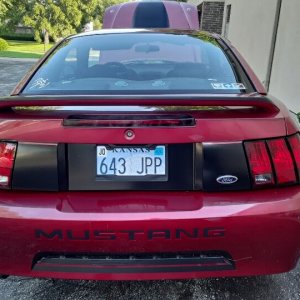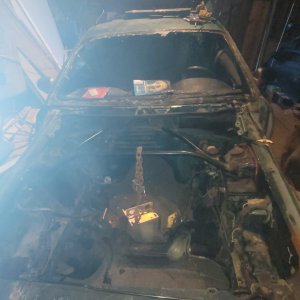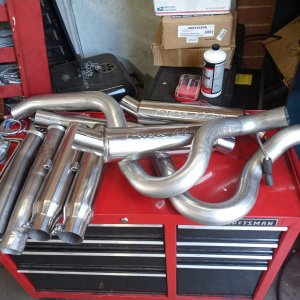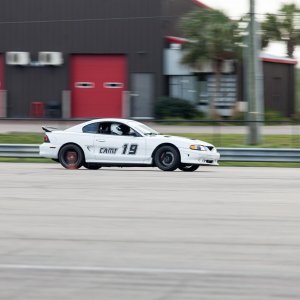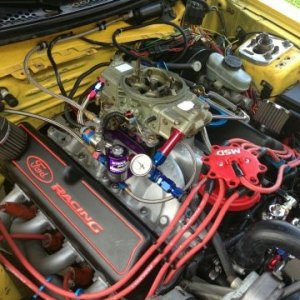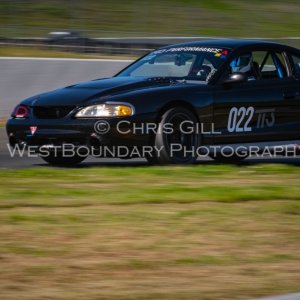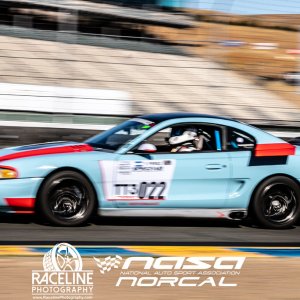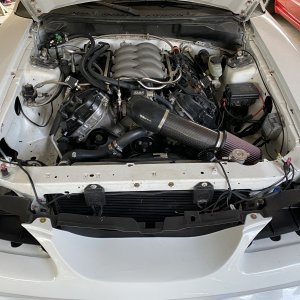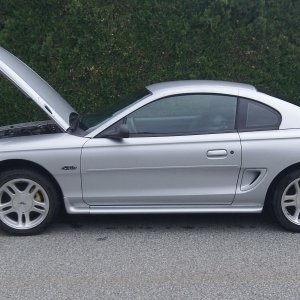The Best Stuff To Put On Your Mustang Right Away
By Tom Wilson
August 1, 2002
http://www.mustangandfords.com/proj...8-tips-to-modifying-your-mustang/viewall.html
OP Comments: I came across this article online and wanted to share it with you guys. It might help with any question new-to-the scene Mustang owners might have.

Where to start? It's the eternal question for Mustangers looking to maximize power, minimize money spent, and lay down a good foundation for power adders to come. And, as we read our mail here in the palatial 5.0&SF ivory tower, we understand there are always new enthusiasts looking for direction with their first Mustang power-parts buying decisions.
When it comes to outfitting a Mustang for everyday street duty, there is little controversy about the basics. Let's face it, 5.0 Mustangs have been around in their familiar EFI state for 15 years now, and the 4.6 machines are entering their sixth year of production. In all that time, the industry has worked out what's worth bolting on and what isn't. We can say that because we've just finished polling a wide variety of Mustang shops on what they offer their customers, and largely the advice is the same: gears, pulleys, and breathing. Of course, the devil is in the details, and that's exactly where we're headed in this article. Ultimately you'll need to decide precisely what combination of parts is best for your final performance goals, but this article is designed to help you make those decisions.
Have A Plan
It's vital to generate a plan when modifying your Mustang. Like a blank canvas, a stock Mustang can be worked into one of many different forms by a savvy owner, or turned into a mishmash by someone in a hurry who isn't quite certain of what they want.
So, before browsing the ads and catalogs, take the first real step: Tell yourself where you want your Mustang to end up when you are finished working on it. Nice daily driver? Drag car? Occasional slalom tool? All are worthy goals but require somewhat different parts. For example, a daily commuter, especially one destined to go on long road trips, is going to want taller gearing than a daily driver that sticks mainly around town and sees several slaloms a year.
By choosing a performance path to follow, you'll make fewer wrong financial turns along the way.
We Ask The Question
To provide the direction for those important first steps, we polled Ford specialty shops and parts manufacturers. Our question was, "What combina-tion of parts do you recommend for the 5.0 or 4.6 owner who's just starting out-the guy who needs simple, affordable improvements?" We wanted to stick mainly to bolt-on parts-and we figured we really didn't have to tell you a $4,000 blower is a good way to improve power.
A few shops took this time to point out they don't see a tremendous number of stone-stock 5.0s anymore, but the 4.6 cars still show up just the way Ford bolted them together. Others reported the occasional stock 5.0 still comes calling. So if you are going to buy a used 5.0, don't be surprised if you have to search some to find a totally stock one, although nicely prepped ones are definitely out there as well. If the car already has the parts you want, you'll no doubt save money buying them that way, rather than piece-meal over the counter-and, the labor is already done.
When getting down to the hardware during our poll, the answer almost always started out with a barrage of return questions: "What year?" "5.0 or 4.6?" "Daily driver or street/strip car?" "Automatic or manual?" We could only say we were talking hypothetically, and from there the tuners tended to zero in certain hardware combinations they found most useful-or pointed out dead ends to avoid.
Gears
Bang for the buck, there is no better whack in the back than a set of final drive gears in the ol' 8.8-inch differential. That's a universal recommendation, so if you have truly limited time and money-and that's a lot of us-then just a set of gears is a smart move. They won't make any more power, but they'll better use what you do have.

The lingering effects and mental attitudes of two fuel crises were still around when the first EFI 5.0s hit town, so a ton of the earlier Fox Mustangs came with 2.73 gears. These are real freeway flyers, the sort of lazy cruisers that keep rpm to 1,800 on the interstate and make you run all the way through each gear in town. They have no performance potential, unless you're running at Daytona and want to use Second, Third, and Fourth gears instead of Third, Fourth, and Fifth. We did that once with Dario Orlando of Steeda Autosports-and, believe us-6,000 rpm in Fourth with 2.73s can be plenty entertaining, but not around town.
By 1990, 3.08s seemed the standard in manual-transmission 5.0s. Again, their main claim to fame is fuel economy, and each transmission gear is needed for daily driver acceleration.
The lowest optional gears available off the showroom floor have been 3.27s. On a 5.0 these are the tallest of what could be called performance gears. That said, it's a small percentage of enthusiasts who really prefer this ratio. They have a mainstream feel, although 3.27s are low enough that you can skip gears when accelerating at the depressingly common tortoise rates of modern traffic. They are nicely relaxed on the freeway, and for a long-distance commute-as is common out West-3.27s could be a workable choice. If you're stepping up from 3.08s, you won't feel much difference, though. Typically it takes a two-step jump-from 2.73 to 3.27, for example-to really feel the difference.
Another place 3.27s could help is with high-torque engines that would simply blow the tires away with steeper gears. It takes high blower or turbo boost to make this sort of power, so you have to be aiming near the outer limits to really need these gears for that reason.
Then we come to 3.55s, the best all-around gear in a manual transmission 5.0. Acceleration is notably sparked up, yet the freeway cruise is easily within normal engine rpm, even at today's elevated, super-legal freeway velocities. Even if your combination is naturally aspirated or packs 10 pounds of boost, 3.55s work.
These are also the first ratio where you might consider skipping First gear in a 5.0 occasionally. This will only happen on downhill starts, but the point is the gears are short enough to be a real help in moving a Mustang.
So, light-duty acceleration may mean you can jump from Second to Fourth gear and save some work while getting into a better fuel-economy profile. In fact, for around- town Mustangs that are always accelerating away from traffic lights, 3.55s often do well on mileage because the engine doesn't have to work as hard. At the same time, First gear isn't so short that it feels more like a nuisance than a help.
On the other hand, some enthusiasts are not concerned about fuel mileage. They figure there's little financial incentive between 17 and 21 mpg, so they'll take the racier gear and not worry about the fuel burn.
The Second great 5.0 gear ratio choice is 3.73s. Now we're getting definitely sporty. First gear is short but really digs in when trying hard. The freeway "cruise" is getting well above 2,000 rpm when you're late to work. But for nearly all but the most laid-back enthusiasts, 3.73s are still quite street able.
If your ultimate plans call for a blower, then 3.73s could be too much, especially in a lighter car. If you'll have just basic equipment, and are foregoing the 400 pounds of stereo gear; another 100 pounds of rollcage; and who-knows-how-heavy, cast-aluminum aftermarket rims, then 3.55s will suffice with a blower on the street. At the track you'll probably still want to go deeper.
Then there are 4.10s. Well, too much is just right for a lot of folks. If squirting a couple of gears away from a light is all you're doing, and you just have to have it all, then 4.10s will absolutely put the snap in an otherwise near-stock 5.0 powertrain. They are too much with a blower, and the engine will buzz along at 2,500 rpm at 70 mph with standard-height tires. If powerslides are your thing, 4.10s will light 'em up in Second gear with ease.
One place 4.10s give good gearing is on a street/strip car running a smog-legal, near-stock engine and tall slicks. The combination is track-oriented, but still easily capable of driving itself on public roads between tracks using stock height tires. The tall slicks will just allow Fourth gear through the lights at the track; stock-height tires and 4.10s mean a performance-killing shift into Fifth at the big end of the track.
On road courses, 4.10s are too much. You'll need Fifth on the longest straights, and tire spinout of the slow corners is a problem.
If your 5.0 has an automatic, step everything up one gear ratio. That makes 3.73s the default cogs for almost every performance automatic Mustang.
Likewise, 4.6 Mustangs simply cannot match the excellent low-end torque of the 5.0. This is most telling right off idle and up through a couple thousand rpm, where the 4.6 is a bit flat compared to a 5.0. That means more rear gear is useful.
At the other extreme, the 4.6 is smoother at higher rpm than the 5.0, so it can wing along a little faster on the freeway and not feel like a McCormick reaper at full chat. That makes the 3.73 gears the best choice for all-around manual-transmission 4.6 GTs, and a great choice for daily driver automatics as well.
The 4.10s in a 4.6 car are still somewhat short, but if you don't mind a 2,500-rpm freeway cruise, they do give the little V-8 enough leverage for sporty acceleration while still not threatening wheelspin every time you open the throttle. This is especially true with 4.6 Cobras and their extra-high-rpm range. As Fairway Sport & Performance put it, "On the Cobras ... go with 4.10 gears ... You're not tapped out in Fourth at the end of the quarter, and not excessively low geared in Fifth."
Pulleys
By reducing parasitic losses to the water pump (mainly), underdrive pulleys free up a bit of power. They are also one of the least expensive and easiest to install of the bolt-ons. Typically you'll see 7-12hp gains on a chassis dyno with pulleys.

By all means, stick with street pulleys and stay clear of race-ratio pulleys. By definition Ford puts just enough gearing in the pulley system to keep the alter-nator charging and the water pump circulating coolant at idle. To achieve their performance gain, underdrive pulleys cut into Ford's worst-case-scenario pulley ratios, so you'll typically see the alter-nator go off-line at idle, and the cooling will be sketchy in truly hot weather and stop-and-go traffic. Thus, Phoenix and Miami Mustangers, and those seeing plenty of stop-and-go driving, may be happiest with stock pulleys.
Joe Gosinski at Chicane Sport Tuning pointed out that 4.6 owners need to pay special attention to the harmonic damper/crank pulley assembly in aftermarket pulley kits. Most of these use aluminum dampers, which are rapidly worn by the crankshaft seal. As Joe says, "Either use a steel damper or a stainless steel sleeve" on 4.6 crank pulleys to avoid what could be a persistent oil leak.
Cold-Air Intake
Several shops listed cold-air kits from K&N, MAC, or BBK as worthwhile on 5.0s. No one claimed big power gains from these, but they are popular because they don't cost much. As GRC Performance put it, "...on 5.0s, cold-air induction systems are not too much money, and they're pretty effective."

If you are ultimately keeping your Mustang naturally aspirated, then a cold-air kit should free up a few horsepower via a less-restrictive intake path. However, if you are working your way to a supercharger one of these paychecks, then you might want to save the cold-air-kit money as your blower kit could include a new air-inlet system anyway. It would be worth a look at the blower kit before opting for the cold air.
When shopping for a cold-air kit, keep in mind that a true cold-air intake draws air from somewhere besides the engine compartment. That's the whole idea-avoiding hot, turbulent underhood air the way the stock system does, but with larger, smoother tubing and less-restrictive air filters. If for some reason you do end up with an underhood open-element air filter, make sure it has a fan-wash shroud. That's a piece of metal or plastic that shields the air filter from direct engine-cooling fan action. If you don't have this, you can end up with an erratic idle and other driveability hair-pullers.
By Tom Wilson
August 1, 2002
http://www.mustangandfords.com/proj...8-tips-to-modifying-your-mustang/viewall.html
OP Comments: I came across this article online and wanted to share it with you guys. It might help with any question new-to-the scene Mustang owners might have.

Where to start? It's the eternal question for Mustangers looking to maximize power, minimize money spent, and lay down a good foundation for power adders to come. And, as we read our mail here in the palatial 5.0&SF ivory tower, we understand there are always new enthusiasts looking for direction with their first Mustang power-parts buying decisions.
When it comes to outfitting a Mustang for everyday street duty, there is little controversy about the basics. Let's face it, 5.0 Mustangs have been around in their familiar EFI state for 15 years now, and the 4.6 machines are entering their sixth year of production. In all that time, the industry has worked out what's worth bolting on and what isn't. We can say that because we've just finished polling a wide variety of Mustang shops on what they offer their customers, and largely the advice is the same: gears, pulleys, and breathing. Of course, the devil is in the details, and that's exactly where we're headed in this article. Ultimately you'll need to decide precisely what combination of parts is best for your final performance goals, but this article is designed to help you make those decisions.
Have A Plan
It's vital to generate a plan when modifying your Mustang. Like a blank canvas, a stock Mustang can be worked into one of many different forms by a savvy owner, or turned into a mishmash by someone in a hurry who isn't quite certain of what they want.
So, before browsing the ads and catalogs, take the first real step: Tell yourself where you want your Mustang to end up when you are finished working on it. Nice daily driver? Drag car? Occasional slalom tool? All are worthy goals but require somewhat different parts. For example, a daily commuter, especially one destined to go on long road trips, is going to want taller gearing than a daily driver that sticks mainly around town and sees several slaloms a year.
By choosing a performance path to follow, you'll make fewer wrong financial turns along the way.
We Ask The Question
To provide the direction for those important first steps, we polled Ford specialty shops and parts manufacturers. Our question was, "What combina-tion of parts do you recommend for the 5.0 or 4.6 owner who's just starting out-the guy who needs simple, affordable improvements?" We wanted to stick mainly to bolt-on parts-and we figured we really didn't have to tell you a $4,000 blower is a good way to improve power.
A few shops took this time to point out they don't see a tremendous number of stone-stock 5.0s anymore, but the 4.6 cars still show up just the way Ford bolted them together. Others reported the occasional stock 5.0 still comes calling. So if you are going to buy a used 5.0, don't be surprised if you have to search some to find a totally stock one, although nicely prepped ones are definitely out there as well. If the car already has the parts you want, you'll no doubt save money buying them that way, rather than piece-meal over the counter-and, the labor is already done.
When getting down to the hardware during our poll, the answer almost always started out with a barrage of return questions: "What year?" "5.0 or 4.6?" "Daily driver or street/strip car?" "Automatic or manual?" We could only say we were talking hypothetically, and from there the tuners tended to zero in certain hardware combinations they found most useful-or pointed out dead ends to avoid.
Gears
Bang for the buck, there is no better whack in the back than a set of final drive gears in the ol' 8.8-inch differential. That's a universal recommendation, so if you have truly limited time and money-and that's a lot of us-then just a set of gears is a smart move. They won't make any more power, but they'll better use what you do have.

The lingering effects and mental attitudes of two fuel crises were still around when the first EFI 5.0s hit town, so a ton of the earlier Fox Mustangs came with 2.73 gears. These are real freeway flyers, the sort of lazy cruisers that keep rpm to 1,800 on the interstate and make you run all the way through each gear in town. They have no performance potential, unless you're running at Daytona and want to use Second, Third, and Fourth gears instead of Third, Fourth, and Fifth. We did that once with Dario Orlando of Steeda Autosports-and, believe us-6,000 rpm in Fourth with 2.73s can be plenty entertaining, but not around town.
By 1990, 3.08s seemed the standard in manual-transmission 5.0s. Again, their main claim to fame is fuel economy, and each transmission gear is needed for daily driver acceleration.
The lowest optional gears available off the showroom floor have been 3.27s. On a 5.0 these are the tallest of what could be called performance gears. That said, it's a small percentage of enthusiasts who really prefer this ratio. They have a mainstream feel, although 3.27s are low enough that you can skip gears when accelerating at the depressingly common tortoise rates of modern traffic. They are nicely relaxed on the freeway, and for a long-distance commute-as is common out West-3.27s could be a workable choice. If you're stepping up from 3.08s, you won't feel much difference, though. Typically it takes a two-step jump-from 2.73 to 3.27, for example-to really feel the difference.
Another place 3.27s could help is with high-torque engines that would simply blow the tires away with steeper gears. It takes high blower or turbo boost to make this sort of power, so you have to be aiming near the outer limits to really need these gears for that reason.
Then we come to 3.55s, the best all-around gear in a manual transmission 5.0. Acceleration is notably sparked up, yet the freeway cruise is easily within normal engine rpm, even at today's elevated, super-legal freeway velocities. Even if your combination is naturally aspirated or packs 10 pounds of boost, 3.55s work.
These are also the first ratio where you might consider skipping First gear in a 5.0 occasionally. This will only happen on downhill starts, but the point is the gears are short enough to be a real help in moving a Mustang.
So, light-duty acceleration may mean you can jump from Second to Fourth gear and save some work while getting into a better fuel-economy profile. In fact, for around- town Mustangs that are always accelerating away from traffic lights, 3.55s often do well on mileage because the engine doesn't have to work as hard. At the same time, First gear isn't so short that it feels more like a nuisance than a help.
On the other hand, some enthusiasts are not concerned about fuel mileage. They figure there's little financial incentive between 17 and 21 mpg, so they'll take the racier gear and not worry about the fuel burn.
The Second great 5.0 gear ratio choice is 3.73s. Now we're getting definitely sporty. First gear is short but really digs in when trying hard. The freeway "cruise" is getting well above 2,000 rpm when you're late to work. But for nearly all but the most laid-back enthusiasts, 3.73s are still quite street able.
If your ultimate plans call for a blower, then 3.73s could be too much, especially in a lighter car. If you'll have just basic equipment, and are foregoing the 400 pounds of stereo gear; another 100 pounds of rollcage; and who-knows-how-heavy, cast-aluminum aftermarket rims, then 3.55s will suffice with a blower on the street. At the track you'll probably still want to go deeper.
Then there are 4.10s. Well, too much is just right for a lot of folks. If squirting a couple of gears away from a light is all you're doing, and you just have to have it all, then 4.10s will absolutely put the snap in an otherwise near-stock 5.0 powertrain. They are too much with a blower, and the engine will buzz along at 2,500 rpm at 70 mph with standard-height tires. If powerslides are your thing, 4.10s will light 'em up in Second gear with ease.
One place 4.10s give good gearing is on a street/strip car running a smog-legal, near-stock engine and tall slicks. The combination is track-oriented, but still easily capable of driving itself on public roads between tracks using stock height tires. The tall slicks will just allow Fourth gear through the lights at the track; stock-height tires and 4.10s mean a performance-killing shift into Fifth at the big end of the track.
On road courses, 4.10s are too much. You'll need Fifth on the longest straights, and tire spinout of the slow corners is a problem.
If your 5.0 has an automatic, step everything up one gear ratio. That makes 3.73s the default cogs for almost every performance automatic Mustang.
Likewise, 4.6 Mustangs simply cannot match the excellent low-end torque of the 5.0. This is most telling right off idle and up through a couple thousand rpm, where the 4.6 is a bit flat compared to a 5.0. That means more rear gear is useful.
At the other extreme, the 4.6 is smoother at higher rpm than the 5.0, so it can wing along a little faster on the freeway and not feel like a McCormick reaper at full chat. That makes the 3.73 gears the best choice for all-around manual-transmission 4.6 GTs, and a great choice for daily driver automatics as well.
The 4.10s in a 4.6 car are still somewhat short, but if you don't mind a 2,500-rpm freeway cruise, they do give the little V-8 enough leverage for sporty acceleration while still not threatening wheelspin every time you open the throttle. This is especially true with 4.6 Cobras and their extra-high-rpm range. As Fairway Sport & Performance put it, "On the Cobras ... go with 4.10 gears ... You're not tapped out in Fourth at the end of the quarter, and not excessively low geared in Fifth."
Pulleys
By reducing parasitic losses to the water pump (mainly), underdrive pulleys free up a bit of power. They are also one of the least expensive and easiest to install of the bolt-ons. Typically you'll see 7-12hp gains on a chassis dyno with pulleys.

By all means, stick with street pulleys and stay clear of race-ratio pulleys. By definition Ford puts just enough gearing in the pulley system to keep the alter-nator charging and the water pump circulating coolant at idle. To achieve their performance gain, underdrive pulleys cut into Ford's worst-case-scenario pulley ratios, so you'll typically see the alter-nator go off-line at idle, and the cooling will be sketchy in truly hot weather and stop-and-go traffic. Thus, Phoenix and Miami Mustangers, and those seeing plenty of stop-and-go driving, may be happiest with stock pulleys.
Joe Gosinski at Chicane Sport Tuning pointed out that 4.6 owners need to pay special attention to the harmonic damper/crank pulley assembly in aftermarket pulley kits. Most of these use aluminum dampers, which are rapidly worn by the crankshaft seal. As Joe says, "Either use a steel damper or a stainless steel sleeve" on 4.6 crank pulleys to avoid what could be a persistent oil leak.
Cold-Air Intake
Several shops listed cold-air kits from K&N, MAC, or BBK as worthwhile on 5.0s. No one claimed big power gains from these, but they are popular because they don't cost much. As GRC Performance put it, "...on 5.0s, cold-air induction systems are not too much money, and they're pretty effective."

If you are ultimately keeping your Mustang naturally aspirated, then a cold-air kit should free up a few horsepower via a less-restrictive intake path. However, if you are working your way to a supercharger one of these paychecks, then you might want to save the cold-air-kit money as your blower kit could include a new air-inlet system anyway. It would be worth a look at the blower kit before opting for the cold air.
When shopping for a cold-air kit, keep in mind that a true cold-air intake draws air from somewhere besides the engine compartment. That's the whole idea-avoiding hot, turbulent underhood air the way the stock system does, but with larger, smoother tubing and less-restrictive air filters. If for some reason you do end up with an underhood open-element air filter, make sure it has a fan-wash shroud. That's a piece of metal or plastic that shields the air filter from direct engine-cooling fan action. If you don't have this, you can end up with an erratic idle and other driveability hair-pullers.






